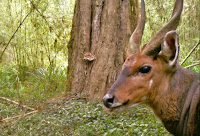Around the world, ticks are one of the most important vectors of zoonotic diseases -- animal diseases communicable to humans -- and they're everywhere.
While North Americans worry about Lyme disease carried by blacklegged or deer ticks, on the other side of the globe, people contend with a different variety of tick-borne fevers. A new study by UC Santa Barbara researchers and colleagues suggests that the abundance of ticks that carry certain fevers are likely to rise in the future, thanks to a combination of wildlife loss and climate change.
The study used a large-scale experimental test to demonstrate synergistic effects of those phenomena on ticks and their pathogens. The investigators found that total tick abundance and abundance of infected ticks increased dramatically when large animals were lost -- and that this effect was exacerbated in dryer, low-productivity areas. Their analysis appears in the Proceedings of the Royal Society B.
"Our research suggests that large mammal conservation may prevent increases in tick abundance and tick-borne disease risk," said lead author Georgia Titcomb, a graduate student in UCSB's Department of Ecology, Evolution, and Marine Biology (EEMB). "These results are timely and relevant in light of widespread wildlife declines and unpredictable regional climatic shifts in a steadily warming world."
Read more at Tick Tock: Biologists Show Wildlife Loss and Climate Change Can Synergistically Increase Tick Abundance and the Risk of Tick-Borne Disease

No comments:
Post a Comment